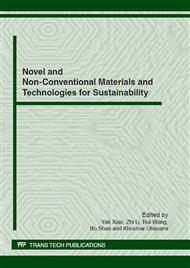p.910
p.915
p.919
p.928
p.932
p.939
p.946
p.952
p.958
Experimental Research on Interfacial Bond Performance in Rock Anchor with High-Performance Grouting Medium
Abstract:
There exist the problems such as low bond strength and bad durability in the ordinary grouting slurry of the ground anchor system at present. The high-performance grouting mediums RPC (Reactive Powder Concrete) and DSP (Densified Systems containing homogeneously arranged ultrafine Particles) would become the potential replacement of grouting medium in ground anchor resulting from their high compressive strength, durability and toughness. Based on a series of pull-out tests on ground anchors with different high-performance grouting medium of RPC and DSP , different bond length in the construction field, the bond performance on the interfaces between anchor bolt (deformed steel bar) and grouted medium as well as between grouted medium and rock mass was studied. The results indicate that the interfacial bond strength between RPC or DSP and deformed steel bolt ranges within 23-31Mpa, far greater than that (about 2-3MPa) between the ordinary cementitious grout and deformed steel bar. Even though the interfacial bond strength between the grouted medium and rock mass of limestone was not obtained in the test since the failure mode was pull-out of those steel bar rather than the interface shear failure between grouted medium and rock mass, the bond stress on the interface reached 6.2-8.38 MPa, also far greater than the bond strength (about 0.1-3MPa) between the ordinary cementitious slurry and rocks.
Info:
Periodical:
Pages:
932-938
Citation:
Online since:
June 2012
Authors:
Price:
Сopyright:
© 2012 Trans Tech Publications Ltd. All Rights Reserved
Share:
Citation:


